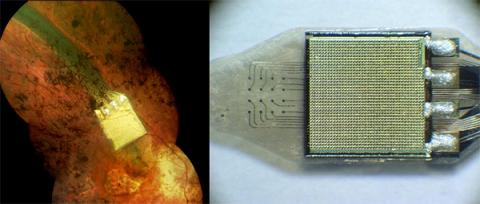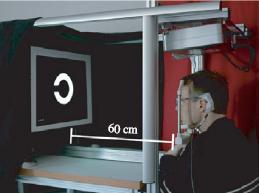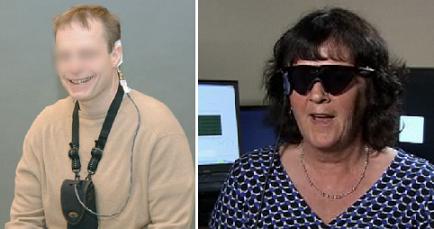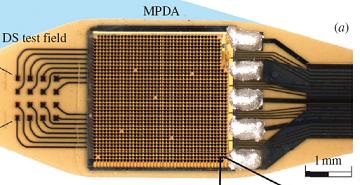
Scientists in Germany have developed a retina implant to restore vision to the blind that hints at the augmentation cyborgs may receive in the future. The device, developed by Retina Implant AG, is an array of 1500+ photodiodes (roughly 38×40 pixels) that is surgically placed under the retina. Light that enters the eye stimulates the photodiodes which send electric currents through the underlying neurons. In a recent article in the Proceedings of the Royal Society B, researchers describe how blind patients (mostly suffering from retinitis pigmentosa) were able to see light and dark areas and discern basic shapes only a week after their surgeries. One man was even able to see the difference between objects, and read large letters! That would be remarkable enough, but implanted patients also reported a sensitivity to infrared light. That’s right, the retina implant could only provide very basic vision, but it did so in an extended spectrum. Cybernetic implants like these may not only be able to restore sight to the blind, they could let them see things that no normal person has ever seen before with their own eyes.

There are many types of blindness, but inheritable conditions like retinitis pigmentosa affect millions all over the world. Many of these people will lose their vision slowly over many years. Adjusting to the loss of vision is difficult at any age, but perhaps especially so after decades of sight. Retinal implants could restore limited visual sensitivity to thousands or millions around the world, helping them maintain the lives they have built up so carefully.
Retina Implant AG isn’t the only company working on cybernetic fixes for loss of vision. Lawrence Livermore National Labs has been developing the Argus series of retina implants for several years. There is a major difference between the two approaches, however. The Argus uses an external camera to collect an image, which it then transmits to the epiretinal implant in the eye (using wireless RF transmission). Retina Implant AG’s device doesn’t have an external camera – it sits under the retina collecting light through the pupil, which it then transmits directly to the eye’s neurons via electrical stimulation. Both devices rely on external power supplies of some kind.
*Correction 11/9/10: References to subretinal and epiretinal placement for the Argus and Retina Implant AG device were accidentally swapped. Argus is placed on the ‘front’ of the retina (epiretinal) while the German device is placed ‘under’ the retina (subretinal).

Besides the difference in approach, there’s also differences in capability. The latest Argus III device is aiming to use 200+ pixels, the Retina Implant AG device already has 1500+. The German retina implant also has up to an 11 degree range of vision, and can handle 10 to 100,000 Lux (this roughly corresponds to a range from a dim room to sunlight). In this way, I think the Retina Implant AG device is actually ahead of the Argus.
However, we should keep in mind that the German studies are still relatively new. They were still in cat models four years ago. The Proceedings of the Royal Society B article that was recently published is based off of three patients from an eleven patient group. Of those eleven, at least five saw improvements in vision, two saw greatly improved sensitivity to light and shapes, and one man could actually distinguish between forks and apples on a table, and read. He even pointed out when doctors misspelled his name (MIKA instead of MIIKA) on the testing screen. Miika’s success is wonderful, but there’s still the 10 other people to consider. Perhaps Retain Implant AG’s device is better than the Argus, but will it be more successful for each patient? Hard to say at this point.
Eberhart Zrenner, the lead author of the recent publication on Retina Implant AG’s device, is already working with a new set of patients using an improved version of the implant. These 25 people will have implants that receive power from a source located behind the ear instead of a pack worn around the neck. In the future these devices will become more streamlined, with higher resolution, and a greater field of vision.

As cool as all of this restoration of vision may be, I was really intrigued by one of the ‘side effects’ of this device – patients could see into the infrared. The photodiodes used in the implant are sensitive well into the IR (most photodiodes that pick up visual light are) so patient’s responded to IR light in the tests. That’s awesome, and wonderfully scifi. This development demonstrates that even the first generation of retina implant users could have senses outside the normal human range. Even before we get the resolution of average vision, we’ll have a kind of enhanced vision. Very cool.
The German researchers also exposed another augmentation possibility, though I doubt they’d see it in that way. On the retina implant, next to the 1500 photodiode array, was a 4×4 matrix of direct stimulation points. No photodiodes, just electrical contacts. Using that 4×4 pattern, doctors were able to get their newly implanted patients to see small dots, vertical and horizontal lines, and even simple shapes (like ‘L’). Why is this augmentation? Imagine you have an implant, and it comes with a nice big photodiode array with high resolution so you can see things around you. Now, on top of this “normal vision” you could place some “augmented reality vision”. Maybe you could hook up your implant to a GPS signal and get an arrow that pointed towards where you wanted to go. Again, even with these first generation (primitive?) retina implants you have the possibility for cybernetic augmentation. Even if they too would be primitive at first.

I should point out that retina implant devices with external cameras (like Argus) could mix in the AR visual cues much more easily. Just take the input from the camera add the graphics and then process the new image like you would normally before you sent it to the eye implant. In either case, it seems like augmented reality is a natural fit for cybernetic vision. Indeed, many people (science fiction writers foremost among them) have pointed to these kind of digital overlay enhancements as one of the primary reasons why you would want cybernetic eyes in the first place.
In fact, I suspect that while retina implants may help with restoring sight in the near term, that will be the least of their impact in the long term. If you have a damaged retina we may be able to heal it rather than replace it. Hans Keirstead is already working on a stem cell treatment that may be able to cure forms of retinal blindness. By the time we get retina implants up to the levels of human vision, we may no longer need to rely on them for vision restoration. Augmentation may ultimately be the only real reason to get an implant.
Still it doesn’t matter whether you have retinitis pigmentosa and are looking for a fix, or if you are interested in human enhancement, the work done in Germany has to be exciting. The highest density photodiode array I’ve ever heard of has had success in someone’s eye. Artificial vision is getting better, and becoming a cyborg has never looked so good.
[image credits: Retina Implant AG via Discover]
[sources: Retina Implant AG, Discover, Zrenner et al 2010 Proc. Roy. Soc. B (PDF)]


